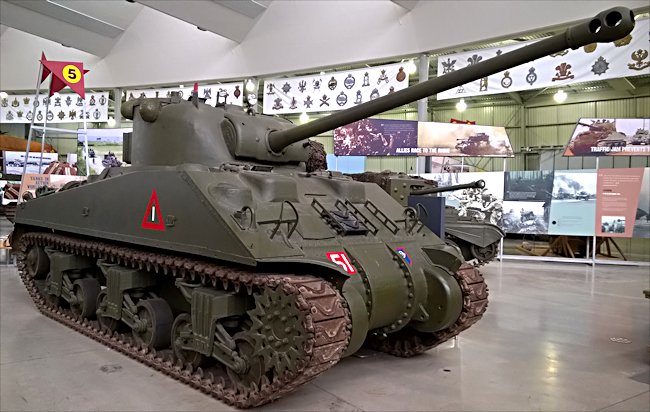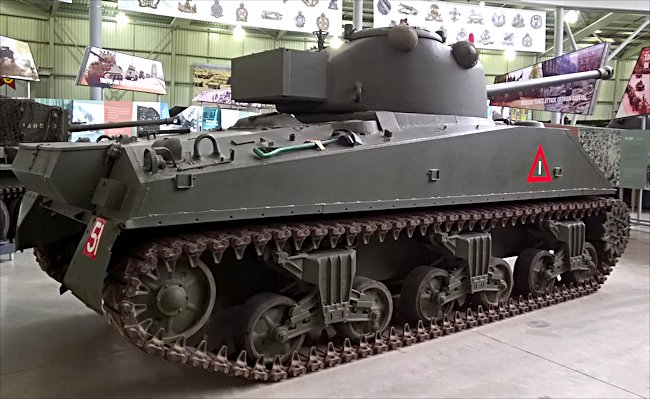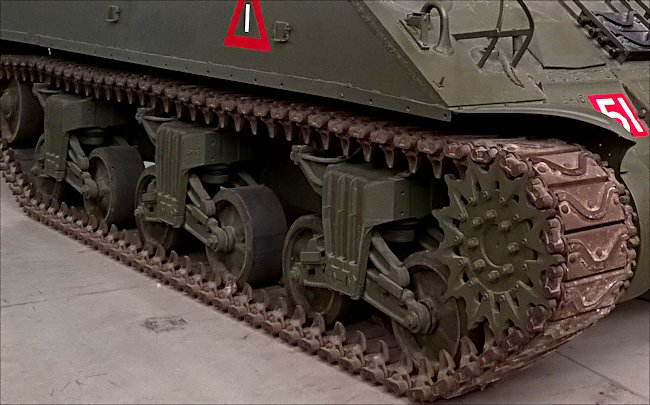The Sherman Firefly 17pdr Tank
This British Sherman Firefly 17-pounder WW2 tank can be found at the Tank Museum, Bovington, Dorset, England.

Sherman Firefly Tank at the Tank Museum, Bovington
On the 8th August 1944, Sherman Firefly gunner Joe Ekins knocked out three German Tiger MkI Tanks during a successful allied ambush, in Normandy, France. Gunner Ekins was a former shoe factory worker before joining the army. He was 21 years old and had undergone tank crew training at Bovington before joining the 1st Northamptonshire Yeomanry.
He had landed on the D-Day beaches and fought his way inland. Joe's regiment faced their greatest danger when the German armoured Divisions were ordered to counter attack and drive the allies back into the sea. They found places to conceal their tanks. Some in woods and others behind a French country estate brick wall. A convey of Tiger I tanks were spotted heading towards the coast lead by the German tank ace Michael Wittman. The British tanks waited until the enemy vehicles were close before opening fire. Most of their rounds hit the side of the German tanks, not the very heavily protected front. Ekins hit and destroyed three Tiger tanks that day.

Sherman Firefly Tank from the side. Notice the additional armoured radio box on the back of the turret.
The Sherman Firefly was the first allied tank capable of knocking out a German Panther or Tiger tank. It was built just in time for the D-Day landings but not in enough numbers to replace all the Sherman tanks used by the British, Polish, Free French and Commonwealth forces. It normally provided support and fought with three other Sherman tanks armed with the original, less powerful, 75 mm gun.
The Firefly's secret was its long high velocity 17-pounder gun (76.2 mm). Colonel George Witheridge conducted successful trials to fit the longer gun to a modified Sherman turret at the Lulworth Gunnery School. The Firefly tank crews had to learn how to shoot quickly and accurately to survive. The Firefly's gun may have been upgraded but the tank's armour was still the same thin armour found on all other Sherman tanks in 1944. If hit by the gun of a German main battle tank, self propelled gun or 88mm anti-tank gun it did not stand a chance.

Sherman Firefly Tank tracks
The Sherman Firefly tank at the Tank Museum in Bovington is believed to be one of the first off the production line and used as a training tank. The restoration staff at the museum have painted the tank to represent Sergeant Robinson's tank of the 2nd Grenadier Guards. His tank was the first to cross the River Rhine at Nijmegen during Operation Market Garden in October 1945.
One of the identifying features of a Firefly compared with other Sherman tanks, apart from the very long 17-pounder gun, is the additional armoured radio box fitted to the rear of the turret. The 17pdr gun was so large that there was no room for the radio inside the turret. Word soon spread through the ranks of the German Army in Normandy that the Allies had developed a new Sherman with a fearful gun. Information was forwarded on how to identify the Firefly. German anti-tank units and tank crews tried to knock out the Firefly tanks first and then deal with the less dangerous Sherman M4's armed with the 75mm guns.
The crew of the Sherman Firefly had to be reduced from five down to four because of the lack of room. Not only was the gun much bigger but so was the size of the shells it fired compared with the rounds fired from the normal 75 mm Sherman gun. They had to be stored inside the tank and something had to go. The 17pdr gun could fire the new more effective Armour Piercing Discarded Sabot rounds. The sabot is a lightweight outer casing with a tungsten round inside that had a better penetrative power. The sabot falls away after being fired, giving the round greater energy. They were only used in late 1944 and early 1945 as supplies reached the front line.
Where can I see more Sherman Firefly tanks?
In British Military terminology the Sherman I was an M4. The Sherman II was an M4A1 and so on. Additional letters denoted other
features; A for 76 mm M1/M1A2 L/55 gun, B for the 105 mm M4 L/22.5 howitzer, C for the OQF
17 Pounder gun, and Y for the wider tracked HVSS type suspension.
As a result, the Sherman Firefly tanks were named this way :
Sherman Ic - Sherman with welded hull and cast turret with an OQF 17 Pounder gun
Sherman Hybrid Ic - Sherman with cast hull and turret with an OQF 17 Pounder gun
Sherman Vc - M4A4 with an OQF 17 Pounder gun
- Sherman Firefly Ic - Pretoria Regiment base, Salvokop, Pretoria, Gauteng province, South Africa
- Sherman Firefly Ic - Dam Snake Park, Hartebeespoort, North West prov, South Africa
- Sherman Firefly Ic - Museo Historico del Ejercito, Buenos Aires, Argentina
- Sherman Firefly Ic - Comando del III Cuerpo de Ejercito. Camino a La Calera, Cordoba, Argentina
- Sherman Firefly Ic - Regimiento de Infanteria Aerotransportado 14, Cordoba, Argentina
- Sherman Firefly Ic - Museo Storico dei Carristi, Rome, Italy
- Sherman Firefly Ic - Dickie Fritz Moth Hall, Dickie Fritz Avenue, Edenvale (Ekurhuleni), Gauteng prov, South Africa
- Sherman Firefly Ic - Near the Police Station, Hechtel, Belgium
- Sherman Firefly Hybrid Ic - The Technische Dienst collection, Netherlands Army, Netherlands
- Sherman Firefly Hybrid Ic - Private collection, Wommelgem, Belgium
- Sherman Firefly Hybrid Ic - War memorial, Klein-Willebroek Belgium
- Sherman Firefly Hybrid Ic - Monumento ai carristi, Sant'Anna d'Alfaedo, Italy
- Sherman Firefly Hybrid Ic - Caserma Fratelli De Carli, Cordenons, Italy
- Sherman Firefly Hybrid Ic - National Museum of Military History, Johannesburg, South Africa
- Sherman Firefly Hybrid Ic - School of Armour Museum, Tempe Bloemfontein, Free State province, South Africa
- Sherman Firefly Hybrid Ic - War Memorial, Bethlehem, Free State prov, South Africa
- Sherman Firefly Hybrid Ic - Monument for the fallen of the 3rd Airborne Artillery Regiment 1982 war, Cordoba, Argentina
- Sherman Firefly Hybrid Ic with 105mm turret and howitzer - Sandstone Heritage Trust, Free State prov, South Africa
- Sherman Firefly Vc - Arsenalen Tank Museum, Strängnäs, Sweden
- Sherman Firefly Vc - Bovington Tank Museum, UK
- Sherman Firefly Vc - Kevin Wheatcroft Collection, UK
- Sherman Firefly Vc - Cavaleriemuseum, Bernhardkazerne Netherlands
- Sherman Firefly Vc - x2 Bastogne Barracks, Bastogne, Belgium
- Sherman Firefly Vc - Marche-En-Famenne, Belgium
- Sherman Firefly Vc - Remember Museum 39-45, Thimister-Clermont, Belgium
- Sherman Firefly Vc - Polish War memorial, Tielt, Belgium
- Sherman Firefly Vc - Fort de Boncelles, Boncelles, Belgium
- Sherman Firefly Vc - Tank Museum Depot, Vissenaken, Belgium
- Sherman Firefly Vc - Piana delle Orme Museum, Borgo Faiti, Italy
- Sherman Firefly Vc - Bentivoglio Bruno and C. Snc, Via della Bufalotta, Rome, Italy
- Sherman Firefly Vc - Armoured Weapons Museum, Poznań, Poland
- Sherman Firefly Vc - Tyre barracks,Tyre, Lebanon
- Sherman Firefly Vc - Borj Chemali, Lebanon
- Sherman Firefly Vc restored with a 75mm gun and turret - Hermeton-sur-Meuse, Belgium
- Sherman Firefly Vc restored with a 75mm gun and turret - Mopertingen, Belgium
- Sherman Firefly Vc restored with a 75mm gun and turret - Remember 39-45 Museum in Thimister-Clermont Belgium.
- Sherman Firefly Vc - Railway Station, Leopoldsburg, Belgium
- Sherman Firefly Vc M4A2 with Firefly turret - U.S. Army Ordnance Museum, Fort Lee, VA, USA
- Source - Pierre-Oliver Buan - http://the.shadock.free.fr/Surviving_Panzers.html
WW2 tank books

